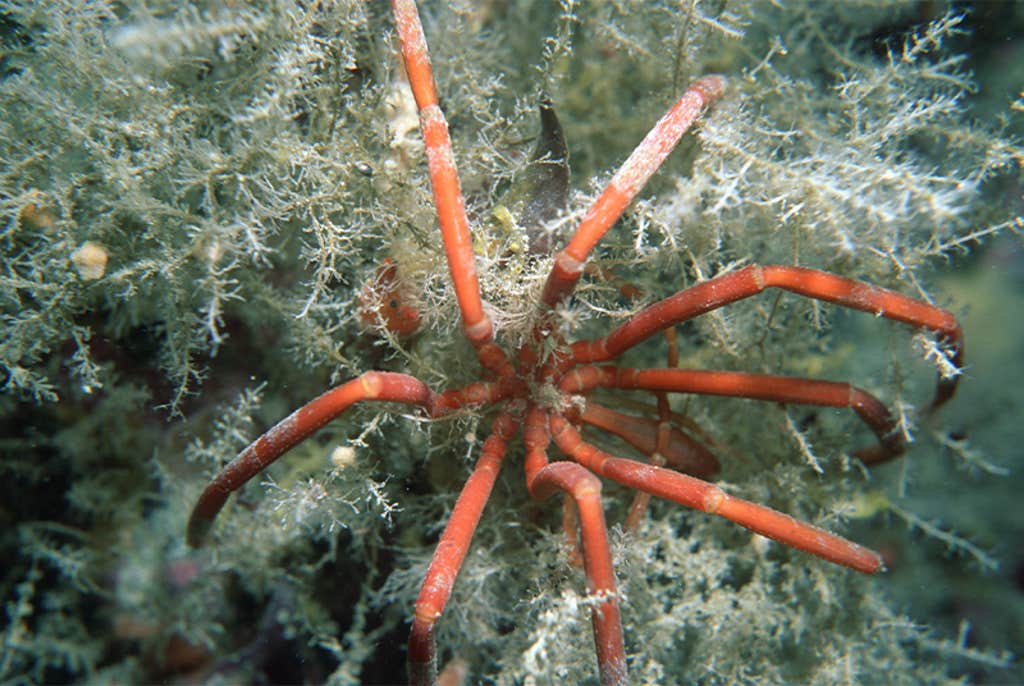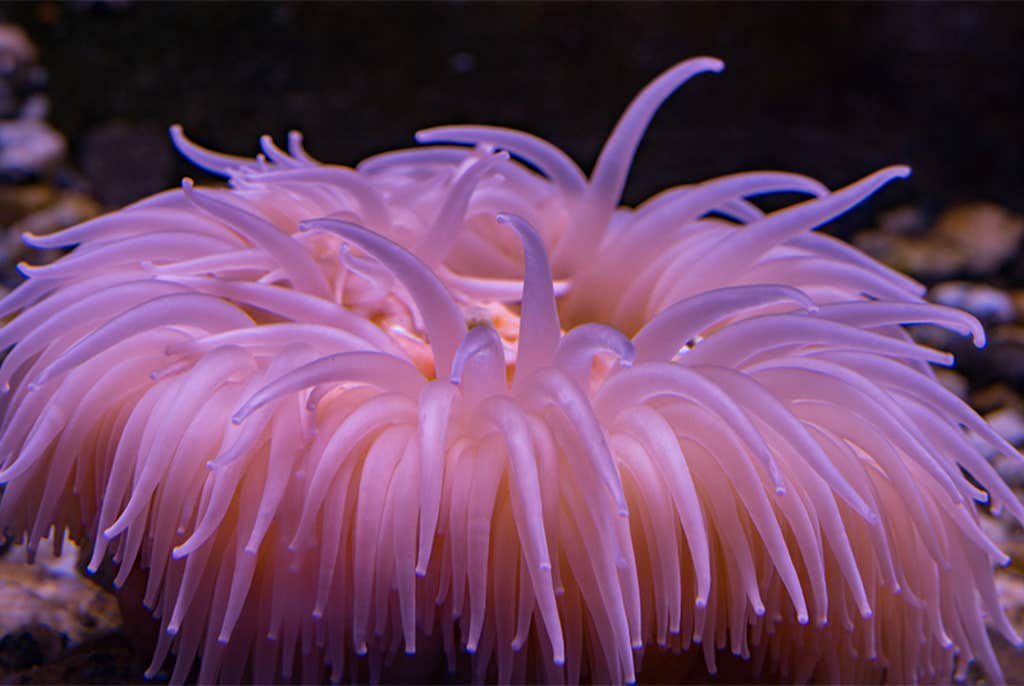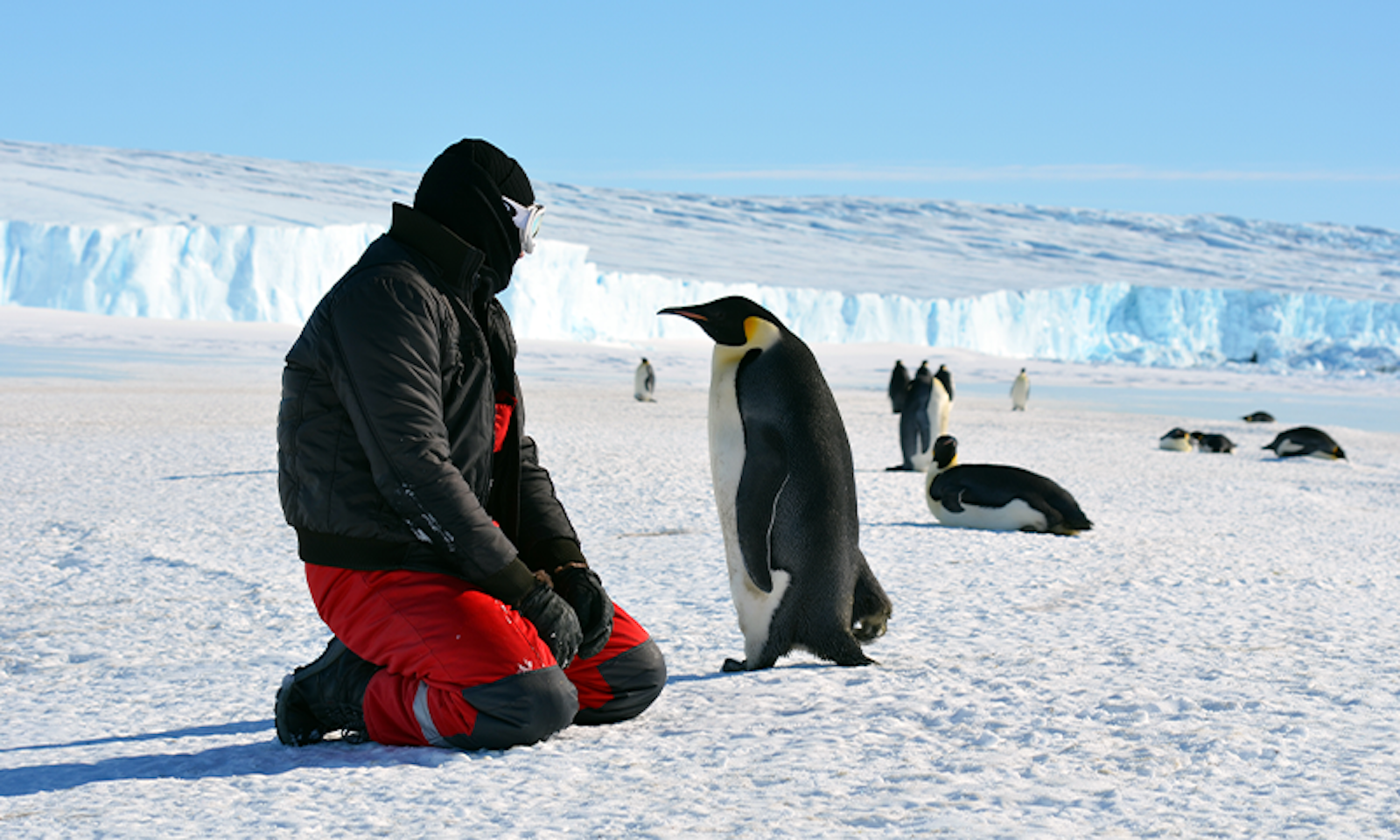Imagine a zoo of Antarctic life. Donning thick winter coats, hats, and gloves, visitors enter the air-conditioned aviary and are met with the raucous braying of Emperor penguins. On rocky escarpments next to sea ice, Adelie penguins comically collect small pebbles while snow petrels fly above. In the marine mammal exhibit, Weddel seals, piebald blimps of blubber, slowly sink into crystal-clear waters. A toddler swaddled in a snowsuit presses her hands against the thick glass, a few invisible inches between her and the Antarctic.
Penguins and seals may be the largest animals here, but it is the benthic fauna, the seafloor-dwellers, who make the biggest impression. These creatures are so otherworldly that they push visitors to reconsider what life can be. There are sea anemones the size of buckets; 12-armed starfish who grow to the size of garbage-bin lids; so-called sea spiders, no relation to terrestrial arachnids, with bodies so small that their reproductive organs and digestive tract reach into their legs. And then there are the fish, including 16 species of notothenioid “icefish” who live in 28 degree Fahrenheit water and keep their organs ice-free by pumping their bodies full of antifreeze proteins.
The imminent collapse of a unique ecosystem remains largely unnoticed.
As visitors leave the main hall of this low-temperature zoo, they walk beneath a replica skeleton of an Anroux’s beaked whale, a species known primarily from a skull that washed up on New Zealand’s shores in 1846. There isn’t space for such far-ranging cetaceans here, but this specimen testifies to the secrets of the Southern Ocean: a place so vast and unexplored that it can easily hide pods of 30 foot-long mammals.
Alas, this center of Antarctic wonders doesn’t exist. It is a vision of Lloyd Peck, a biologist from the British Antarctic Survey who has spent three decades studying the life of Antarctica and the Southern Ocean that surrounds it. With parts of the continent warming rapidly, he sees that they are in danger. Animals who depend on sea ice for breeding—Emperor and Adelie penguins, Weddell seals—are retreating southward, tracking the steadily vanishing ice. The delicate soft corals, sea spiders, and other benthic fauna who have adapted to frigid temperatures are at risk of starving if warmer waters increase their metabolic demands.

Peck’s vision of an Antarctic zoo, seen through his eyes, seems less like a pipe dream and more of a necessity. Yet while conservation organizations and government agencies pour resources into protecting a few charismatic species, the imminent collapse of a unique ecosystem remains largely unnoticed. A zoo represents a life support system for an ailing ecosystem, an insurance policy that could replenish what was lost if humanity’s carbon emissions can be reversed and Antarctica allowed to heal.
“We’ve got seed banks for agriculture, and we’ve got zoos for maintaining failing biodiversity” elsewhere, says Peck. “We have nothing like that for the Antarctic.”
It was not until the mid 19th century that scientists first described an Antarctic animal. One of the first was an amphipod, a member of a crustacean family that includes those Tic Tac-sized sand hoppers who scatter underfoot at the beach. But this one, Glyptonotus antarcticus, grows to the size of your hand—a gigantism found in many of the continent’s creatures. Their exceptional size is likely due to the higher oxygen levels that cold water contains, providing animals with more metabolic fuel for growth.
How Antarctica formed also helped furnish its coastlines with a diversity of life. After separating from South America around 30 million years ago, the circumpolar current—a moat of fast-moving water in the Southern Ocean—-formed a barrier to all but the most powerful of marine creatures. The circumpolar current also separated Antarctica from the warmer waters of neighboring oceans and led to a gradual decline in temperature. Seventy million years ago, the Southern Ocean’s surface temperatures reached a tropical 70 degrees Fahrenheit; now they rarely climb above 34 degrees Fahrenheit.
Cooling was the general trend. But as Earth wobbled on its axis, there were also periods of warming. As it oscillated between subzero and temperate climes, sea ice and glaciers covered and exposed seabeds on the continental shelf. This regular closing and opening of habitats, one theory posits, acted like a “biodiversity pump,” generating the benthic fauna that, in sheltered nooks, can grow into an underwater rainforest of sponges, gorgonian corals, and giant sea anemones.
An estimated 20,000 species live in the deep waters that surround the Antarctic continent, a level of diversity comparable to other marine environments, tropical coral reefs excepted—and little is known about them. “We’ve only got names for 8,000 of them,” says Melody Clark, a molecular biologist at the British Antarctic Survey. A name is merely the starting point of most scientific study; out of those 8,000 species, she adds, life cycles and ecological relationships are only known for a “small handful of the most common species that you find near research stations. So there are huge swathes of the unknown.”
To lose an endemic species in Antarctica is to lose it everywhere.
Clark is particularly interested in molecular adaptations to cold, a phenomenon exemplified by icefish. Unlike every other vertebrate, icefish don’t have red blood cells or hemoglobin, the oxygen-transporting proteins in our bloodstream. Their blood vessels are a third larger than similar-sized fishes from more temperate regions, helping oxygen from their surroundings to circulate freely within their bodies. “They are more unique biologically than elephants, lions, tigers, eagles, marmosets—anything that we care about,” says Peck. Icefish “do life differently.”
Different may now be doomed. Since 1950, the air that circulates around Antarctica has warmed by 3 degrees Celsius, a rate five times faster than the global average. Southern Ocean surface waters are projected to rise by 1 degree Celsius over the next 50 years. For animals adapted to stable, subzero waters, this small rise can have huge consequences. Warmer waters contain less oxygen; the clear-blooded icefish may represent an “evolutionary dead-end,” says Clark.
Their predicament is not unique. By some estimates, two-thirds of the continent’s terrestrial species are expected to decline as Antarctica warms and its sea ice retreats; the prognosis for marine species is also calamitous. Peck and Clark’s own experiments have found that even slight warming causes bryozoans and spirorbid worms—the primary colonizers of coastal seabeds—to undergo metabolic changes that leave them unable to obtain enough nutrients during the four-month-long polar night, when populations of their plankton prey naturally ebb.
So why try to save them at all? What is the value of a species? Who cares if an icefish you’ve never heard of disappears into the patchy imprint of deep time? One common argument is that these animals, their adaptations to the cold, hold secrets to tissue preservation or enzymes that can unlock low-temperature industrial processes. In a less utilitarian vein, these creatures are the evolutionary products of a natural experiment that is unlikely to be repeated. Separated from the rest of the world by the circumpolar current, Antarctica is home to a high proportion of endemic species, roughly half of whom are found nowhere else on Earth.
To lose an endemic species in Antarctica is to lose it everywhere. A piece of Earth’s heritage would vanish. There are no populations from which it might someday be reintroduced—at the moment, at least.

But as long as there is liquid nitrogen, genetic data can be saved indefinitely. Before facilities for live animals are built, both Clark and Peck would like to see a “frozen zoo” for genetic material collected from the continent’s fauna. This would not only provide a foundation for studying the biological underpinnings of cold adaptations. It would, in Peck’s vision of the distant future, allow reintroductions even after extinction. “If it cools down again, you’ve at least got the information to recreate what was there,” he says. “And maybe in 500 years’ time, we could rebuild an ecosystem.”
Storing DNA is much simpler than housing penguins, seals, and the thousands of creatures about whom we know almost nothing, but it would still be a herculean task. To preserve enough of their diversity, at least 30 to 50 individuals from each of the 20,000 Antarctic species would need to be collected. Meanwhile those 20,000 species only account for animals large enough to see with the naked eye.
Antarctica’s microscopic creatures are also extreme cold-adapted and unique; just as its vertebrates are special, so an Antarctic tardigrade or rotifer or nematode is quite different from their temperate-zone relatives. Then there are bacteria, such as those living where mountain winds scour bedrock bare and temperatures dip to -70 degrees Fahrenheit in the darkness of winter. They too would need to be sampled.
As sprawling and complicated as this effort would be, though, it’s not difficult to imagine, especially with the cost of genetic sequencing falling every year. “We could do that quite easily if the money was available,” Clark says. “There just hasn’t been such an initiative yet.”
With yet more resources, captive breeding projects could be developed for Antarctic creatures—not necessarily at the massive scale represented by Peck’s vision of an enclosed ecosystem, though that would represent its ultimate fruition, but enough to ensure that at least a handful of Antarctic endemics pass through the climate change bottleneck. For that to happen, though, work needs start now.
Maybe in 500 years time, we could rebuild an ecosystem.
“We know less about the animal husbandry of keeping those species than any other group of animals,” says Peck. For most species of giant sea spiders, for example, scientists don’t even know what they eat, let alone how to encourage their mating or keep them alive in captivity.
“Even if we start seriously doing this now, we’re probably three decades away from being able to have really good facilities,” he says. “We don’t have maybe more than five decades before we start losing significant numbers of species around the Antarctic. If we don’t get this sort of conservation going, we will start losing species without the ability to do anything about it.”
Just as a city isn’t solely defined by the people who live there, Antarctica is more than its wildlife. It is a place of quietude and vast empty space. For millions of years, enormous chunks of ice have shone in brilliant blue and have been carved by wind and wave into an endless variety of forms. Other than their creaks and pops, the only other sound is the exhalation of a whale. To simulate this space is impossible.
An Antarctic zoo, whether it contains live animals or their genetic sequences, is an ecosystem on life support. It is a decidedly depressing vision; a continent reduced to a few bubbles of captivity. A reminder of a world that was lost. And yet: Wouldn’t it be better to have a reminder than nothing at all? In an ideal world, the worst of climate change would be averted, and Antarctica’s unique menagerie of life would survive unscathed—but now is the time to plan for the worst.
“I often say to my students, if something warms up, what disappears?” Peck says. “It’s the cold areas. There will be hot areas for hot things. There will be warm areas for warm things. But if there are no cold areas, what do you do?” ![]()
Lead image: polarman / Shutterstock






































